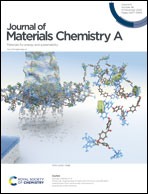Collagen fibers with tuned wetting properties for dual separation of oil-in-water and water-in-oil emulsion†
Abstract
Tuning the wettability of materials is of significance in developing efficient separation materials. Herein, we tuned the wetting properties of collagen fibers (CFs) by surface decoration with Zr4+, and the resultant composite fibers were effective for dual separation of oil-in-water (O/W) and water-in-oil (W/O) emulsions. The as-prepared composite fibers were underwater superoleophobic, with an underwater oil contact angle of 158.4°, which enabled the successful separation of a variety of O/W emulsions by rejecting oil selectively while permitting water permeation. Furthermore, the composite fibers featured underoil hydrophilicity as well as large water-absorbing capacity (4.17 g g−1), which allowed for separating diverse W/O emulsions by capturing water from the W/O emulsions. For the dual separation, the separation efficiency was high up to 99.9995%, and the flux reached 3031 L m−2 h−1. The composite fibers also showed long-term separation stability and good recycling capability. Our strategy might be applied for developing other separation materials that could be applicable for achieving dual separation of O/W and W/O emulsions.



 Please wait while we load your content...
Please wait while we load your content...